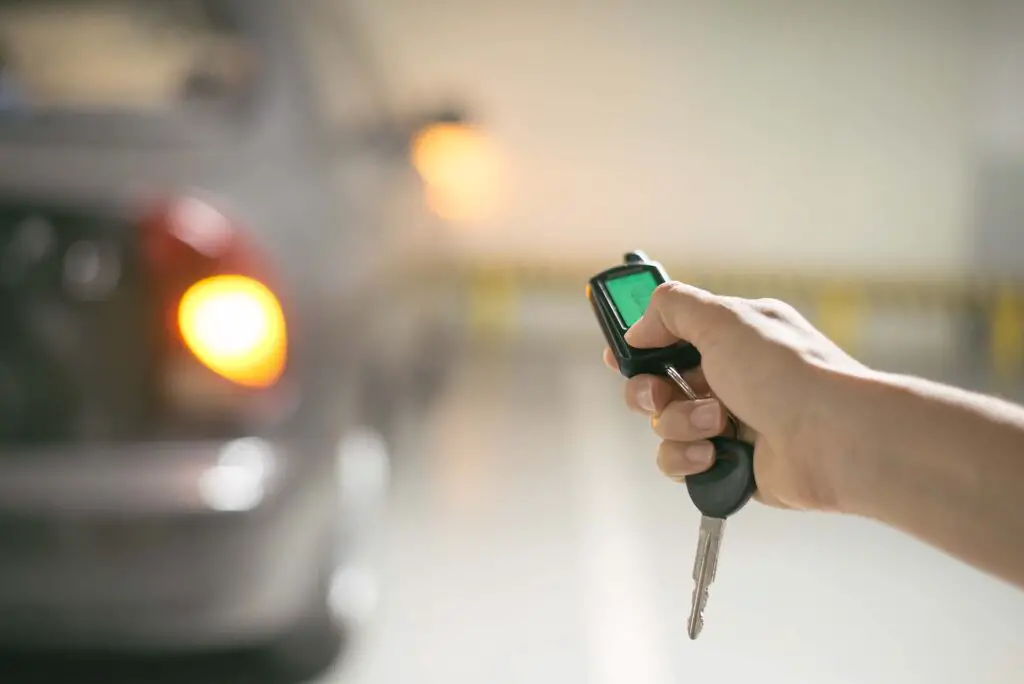Faulty alert systems can go off for as long as twenty minutes, which can bother you and everyone else hearing the noise – especially if this problem keeps happening. Learning how to disconnect the car alarm would be a quick, easy solution. Let’s help you finally get some peace and quiet.
Sometimes, this task is as simple as unlocking your vehicle or starting the engine. If it doesn’t work, locate the alarm’s fuse and disable it or disconnect the car’s battery altogether. Some systems may require more specific disabling methods, so sometimes, you’ll need to consult the user manual.
How Does the Vehicle Alert System Work?
There’s a whole revolution in automobile safety happening, and that includes keeping not only the passengers secure – we’ve got to think about the four-wheeler itself. According to the National Insurance Crime Bureau (NICB), there’s a steady rise in car thefts, with over 1 million four-wheelers being stolen in 2023. It’s better to be safe than sorry, so most of us are equipped with a three-layered shield – our keys, the steering wheel lock, and, of course, the alarm.
An alarm system can be a part of a car’s electronic control unit or a separate module, and it’s based on external sensors that can sense movement. When the unsuspected movement occurs, the system then sets off the alarm, which usually emits a loud, annoying noise. While in most cases, there’s nothing suspicious going on, it’s a crucial indicator when something is actually happening. Either way, to keep a good relationship with your neighbors, it pays off to learn how to disable this safety system.
Why Does the Car Alarm Go Off Without a Reason?
These safety systems are designed to protect your vehicle from theft, but some can activate randomly. There are many different reasons why this can happen, such as:
- Incorrectly placed movement sensors,
- Low battery charge,
- Faulty key fobs,
- Problematic hood latch sensors,
- Improperly installed alarms.
While disabling the system can easily be done, you must get to the bottom of why the problem occurred in the first place. After all, who wants to wake up at 2 am and have to rush to the garage just to keep the neighborhood quiet every night?

What Are the Different Types of Alert Systems?
You can face two kinds of vehicle alarms – factory and aftermarket. Factory alarms are usually reliable, and they rarely go off randomly. However, same-model four-wheelers tend to have identical alarms, which makes it pretty easy for an experienced thief to disable them. Such models can be some of the most stolen cars out there. In the US, the Hyundai Elantra takes this unwanted crown, with almost 50,000 of them disappearing into thin air in 2023.
Because of such risks, many owners opt for an upgrade with aftermarket alarms. The quality of these devices will depend on their brand and type, but there are plenty of high-quality products available out there. To get a clearer picture of which route is the better one for you, here’s an overview of the advantages and disadvantages:
| Pros | Cons | |
| Factory alarms | Good quality and reliable, rarely giving out false alarms | They are basic, hard to upgrade and customize, and are often predictable |
| Aftermarket models | Variety of choices, from simple and affordable, to high-end ones, with many additional features | It can be expensive to install them, and some problems may occur if the person who installed them is not competent enough |
Using the Remote or Manual Key – The Most Simple Solution
Most alarms will stop blaring after you unlock your vehicle, whether with a remote key fob or manually, by using your key. If unlocking the vehicle doesn’t work, try placing the key into the ignition and starting the engine – that usually does the trick.
However, keep in mind that most fobs today have a button designed to trigger an emergency alert system, known as the panic button. Sometimes vehicle owners, by accident, press this button and activate the system. In that case, the blaring sound should stop soon – you can speed it up by unlocking the four-wheeler.
Removing the Fuse Is Another Way of Disabling Warning Systems
One other effective way of disabling these systems is removing the fuse from the fuse box. This process will vary depending on the make and model of your vehicle, but here’s how it generally goes. Four-wheelers usually have two fuse boxes, one located under the hood and the other typically placed in the cabin beneath the steering wheel. To access it, you must take off the trim first. Next, you’ll need plastic tweezers (or pilers) to pull off the fuse and cut the electronic circuit belonging to the alarm system.
The fuse is responsible for sending electronic signals to the alarm system, so once you cut the circuit, the warning noise should stop. If you’re not certain about which one you need to disable, look at the fuse diagram you can usually find on the box.

The User Manual Is Your Guide on How to Disconnect a Car Alarm
If removing the fuse doesn’t work, there is yet another way to make the noise stop. Although it’s not the fastest way, consulting the owner’s manual is always a good solution, no matter what type of alarm system you’ve got. A study has revealed that 1 in 5 drivers, or 21% of them, have never read a single page of the owner’s manual. Don’t be like them – pick up this handy book and you’ll find the solution in no time.
Disconnecting the Battery Is the Last Resort
Removing the battery cable will result in resetting all the electrical systems in your vehicle, including the one belonging to the alarm. Once you do this, the sound should go off. However, keep in mind that your vehicle won’t start until you reconnect the battery.
The battery is usually located under the hood, but keep in mind that it can also be placed in the trunk with certain models. Once you find it, you’ll see two black cables – locate the negative one and disconnect it with the help of suitable tools (pliers or a wrench). There will be a nut holding the cable, so you must loosen it first.
Note that, unlike factory alarms, some aftermarket systems have small backup batteries. They are meant to keep the device working even if the battery is disconnected. The location of these batteries varies, so ensure you find the wanted information in the user manual. Still, keep in mind that they can’t work on their own for long periods when disconnected from the main battery.

Don’t Forget to Reset the Alarm Once You’ve Disabled It
Factory alarm systems are pretty easy to reset. Usually, all you have to do is unlock the doors. Additionally, if it is required to disconnect the battery, the system will reset once you connect it again. On the flip side, aftermarket models are a bit different – to reset them, you’ll need to do a bit more work.
Most of the time, you’ll need to look for an on switch on the device and press it. After you do, make sure the vehicle’s key is in the ignition position while you press the gas pedal. You should hear the beeping sound, which means that you’ve successfully reset the device. If you don’t hear it, try it several more times. If the device is still not reset, try contacting the alarm’s manufacturer for further action.
How to Fix the Issue Causing the Random Alert System Activation?
As we’ve already discussed, there are several reasons why this keeps happening. In order to stop the system from going off randomly, you’ve got to get to the bottom of it. Here are the potential culprits, along with their solutions:
Malfunctioning Key Fob
Properly working key fobs are able to send the signal to a receiver, resulting in locking, unlocking, and starting the vehicle. However, if there are problems with them, they aren’t able to send the signal properly, which can cause the warning noise. Possible solutions are battery replacement and resetting. You should also inspect the device for physical damage. If everything seems fine, the device may need reprogramming. You can do it by yourself or ask for the help of a professional.
Faulty Hood Latch Sensor
If this sensor is faulty, it can cause the alarm to go off. The most common reason this occurs is dirt. So, the solution is simple – all you have to do is clean the sensor. For this, you can use a simple cleaning brush and brake cleaner. Of course, note that the hood latch sensor may be damaged, not only dirty. In that case, you need to replace it.
If you continue hearing the warning sound even after the replacement, it’s time to check the hood latch connection. It’s important not to neglect this step! Not only will problematic connections trigger the alarm, but they can also lead to incorrect commands. Some other issues may also cause this problem, such as damaged sensors, cable fraying, poor pull handle assembly condition, and so on.
The Defective Door Lock Sensor
Since the door lock sensor is located in the actuator, weather conditions can damage it. You should try to protect the connector and identify the leak source. Additionally, the internal wiring is also prone to fail over time, so you must identify which door lock has faulty wiring and replace it.
Low Battery Level
In many cases, a warning sound may occur once you turn on the engine, which points out that the problem is in the dying battery. Even if the alert system goes off and you find the battery dead afterward, it means there are some battery-related issues. All you have to do is check the battery’s voltage. If it’s lower than required (typically 12.6 V), you need to jolt or replace the battery.
Additionally, note that corroded batteries can’t give off the necessary power to all car parts, which alert systems may see as a low-battery situation. Corrosion can be a result of accumulated salt and moisture. Rust can also be a product of overcharging or undercharging a battery. With small corrosion, you can use a wire brush and battery cleaning supply. However, for major corrosion, replacement is always advisable.
Overly Sensitive (Or Weak) Sensor Connection
All vehicle sensors (door, shock, proximity, tilt, and so on) are linked. The alarm is supposed to go off in case any of them is triggered. Check if there is a problem with the electrical connection or wiring with any of them. Additionally, note that some cars, such as Volkswagen or Audi, possess over-sensitive sensors, which can be adjusted.
Malfunctioning Control Module
A defective Electronic Control Unit can send false signals to the alarm system (alongside other car components), leading to its activation. Unfortunately, you probably won’t be able to diagnose and fix the problem by yourself. Let professionals look at your ECU and, if necessary, reprogram it.
Incompetently Installed Alarm System
Aftermarket alert systems may provide additional protection, but it’s not uncommon for them to be improperly installed. In this case, you need to check the instructions and ensure you’ve followed all of them properly – if you’ve installed it on your own. If you’ve done it in an auto shop, go back and let the professionals check the issue.
How Do You Permanently Disconnect the Car Alarm?
There are several reasons why a person would want an alert system disconnected completely. Some people want to upgrade to a higher-quality alarm, while others are tired of dealing with the ignition loss sometimes caused by the faulty anti-theft system. Additionally, disabling the alarm is often required for people who want to ship their vehicle professionally.
To do this, you should first find the alarm’s main control box, usually located under the dash. When you do, disconnect all the wires leading to it. You may also need to remove the fuse that powers the alarm. However, note that this may also disable other features of your car – consult your owner’s manual for more information on which features will be affected.
Can You Drive a Car with the Alarm Disconnected?
The answer to this question depends on what you did to disable the alarm. If the usual unlocking and starting of the vehicle worked, you shouldn’t have any problems. However, removing the fuse can affect some other car’s features – therefore, consult the user manual before you start driving. Naturally, if you’ve disconnected the battery, the car won’t start until you reattach it.
You can also drive a vehicle after disconnecting the alarm’s main box. However, although disabling an alarm can be a good solution at the moment, keep in mind that it provides the necessary protection for your vehicle. It’s not a good idea to go without it, especially if you live in one of the states with the most thefts, such as California, Texas, or Florida.

Don’t Ignore the Alarming Problems – Solve Them!
Random activation of the alarm system may not seem like such a big issue. However, remember that these improper activations may point to more severe issues – ones you won’t be able to fix with simple disabling. Therefore, disconnecting the alert system should be only the initial phase of fixing this problem. After that, you should find out what kind of error is causing the problem. Get it solved, and you’re all set for a quiet road ahead!








